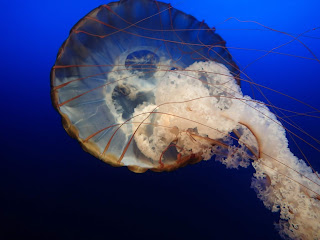July
19-Omaha’s Henry Doorly Zoo & Aquarium
Henry Doorly
Zoo & Aquarium is nationally renowned for its leadership in animal
conservation and research.
Established
in 1894 as the Riverview Park Zoo, today the zoo includes the largest cat
complex in North America.
The Lied
Jungle, opened in 1992 at a cost of $15 million dollars, is one of the world’s
largest indoor rainforests.
It occupies
an 80-foot tall building that spans 1.5 acres. The exhibit allows visitors to
look out from behind a 50-foot tall waterfall.
There is a
trail on the floor of the jungles, as well as a walkway around and above the
animals.
Some of the
animals calling the jungle home are the Blue Monkey, Black Howler Monkey, Otters,
Pygmy Hippopotamus and Bats.
The Desert
Dome, opened in 2002 at a cost of $31.5 million dollars, is the world’s largest
indoor desert.
The dome has
features from deserts around the world: Namib Desert of southern Africa, Red
Center of Australia, and the Sonoran Desert of the southwest United States.
Some of the
animals on exhibit are the Central Bearded Dragon, Desert Cottontail, Wallaby,
Meerkat, and Ocelot.
In addition
to being one of the world’s largest indoor deserts, the Desert Dome’s geodesic
dome is also the world’s largest in the world.
The dome is
137 feet above the main level and 230 feet in diameter.
Located
below the dome is Kingdoms of the Night, the world’s largest nocturnal exhibit
and indoor swamp featuring a wet cave, deep aquarium, a canyon, an African
diorama, a eucalyptus forest, a dry batcave, and a swamp.
Some of the animals found in the kingdom include Aardvark, Bats, American Alligators, Beavers and Porcupine.
The Hubbard
Gorilla Valley exhibit opened in 2004 at a cost of $14 million dollars.
This guy did something I didn't expect
He came up to where I was sitting and planted a kiss on the window.
 The Hubbard
Orangutan Forest includes a outdoor habitat and an indoor habitat.
The Hubbard
Orangutan Forest includes a outdoor habitat and an indoor habitat. Opened in
1977, the Cat Complex has 11 indoor enclosures and 10 outdoor enclosures with
capacity up to 100 cats.
Opened in
1977, the Cat Complex has 11 indoor enclosures and 10 outdoor enclosures with
capacity up to 100 cats.
The Butterfly
and insect Pavilion is a 14,000-square foot total-immersion exhibit.
To enter the exhibit, visitors walk through a set of doors to a antechamber. After the first set of doors are closed, a second set of doors allows entry. The same procedure is done upon exiting the exhibit to ensure there are no hitchhikers on your clothing.
Opened in
1998, the Garden of the Senses is filled with plants, fountains, birds and a
giant sundial.

Expedition
Madagascar is home to lemurs, straw-colored fruit bats and giant rats.
The $73
million Dollar African Grasslands exhibit houses giraffes, rhinos and other
native species including six African elephants.
We watched a
bunch of young cheetah playing and sleeping.
 At a cost of
$16 million dollars, the Walter and Suzanne Scott Kingdoms of the Seas Aquarium
opened in 1995. The building has 71,000
square feet containing a total of 1,200,000 gallons of water.
At a cost of
$16 million dollars, the Walter and Suzanne Scott Kingdoms of the Seas Aquarium
opened in 1995. The building has 71,000
square feet containing a total of 1,200,000 gallons of water.
 At a cost of
$16 million dollars, the Walter and Suzanne Scott Kingdoms of the Seas Aquarium
opened in 1995. The building has 71,000
square feet containing a total of 1,200,000 gallons of water.
At a cost of
$16 million dollars, the Walter and Suzanne Scott Kingdoms of the Seas Aquarium
opened in 1995. The building has 71,000
square feet containing a total of 1,200,000 gallons of water.
Displays
include habitats from polar regions, temperate oceans, the flooded Amazon
rainforest, and coral reefs.
Featured in
the shark tunnel are sharks, stingrays, sea turtles, and coral reef fish.

My favorite was the tanks housing jellyfish.


My favorite was the tanks housing jellyfish.
Some other
zoo exhibits include the Owen Sea Lion Pavilion, a petting zoo and Lozier Imax theater.
In addition
to being a wonderful way for human beings to get a close up look at how so many
different species of animals live in their native habitats, zoos are essential
as a shelter and home to animals that could not survive in the wild either due
to lack of habitat or injury.
Many zoos
have Species Survival Plans which coordinate breeding and population management
programs for threatened and endangered animals.

















































No comments:
Post a Comment